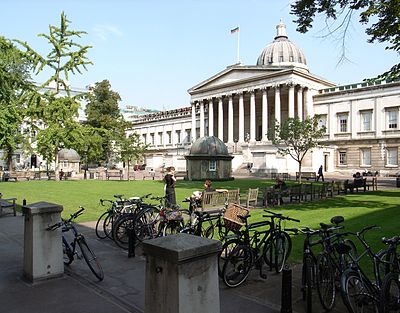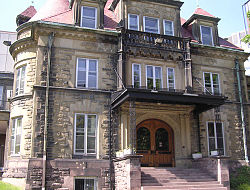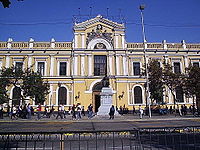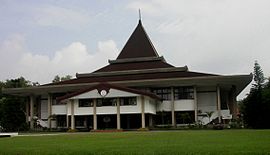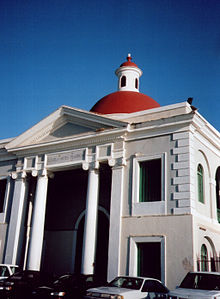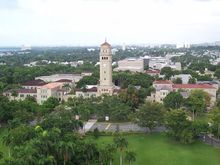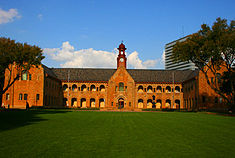- Public university
-
A public university is a university that is predominantly funded by public means through a national or subnational government, as opposed to private universities. A national university may or may not be considered a public university, depending on regions. In some regions of the world prominent public institutions are highly influential centers of research; many of these universities are ranked among the best in the world by THES - QS World University Rankings and the Academic Ranking of World Universities, including the Swiss Federal Institute of Technology Zurich, Imperial College London and the University of California, Berkeley.[1]
Argentina
See also: List of universities in ArgentinaIn Argentina the National Universities, also called "Public or State-run Universities", is the name used to refer to all those institutions whose creation arose from the enactment of a National Congress Act, except for those whose creation preceded that of the state itself (as is the case of the National University of Córdoba and the University of Buenos Aires). They lie as Public Law legal entities and their regular operation funding comes from the national state, pursuant to what is set out on the annual national budget act.
National universities hold the largest share of the entire Argentine university system: counting over 80% of the undergraduate population and with campuses stretched throughout to all provinces comprising the national territory, they account for over 50% of the country's scientific research while additionally providing technical assistance to both the public and private sectors.
Public universities are absolutely free (no fee is paid during the studies), and also the access to books in the universities' libraries. However buying in bookstores and studying material (such as photocopies of books which are very common) is usually paid for by each student. For low-income students there is a great variety of scholarships.
Australia
In Australia, there are 38 public universities and 4 private universities. The private universities are Bond University, the University of Notre Dame Australia (both Australian), and two foreign universities, Carnegie Mellon University (USA) and Cranfield University (UK), which have campuses in Adelaide.
Australia's public universities are variously grouped:
- Some of the Group of Eight are the oldest and most prestigious public universities in Australia and include the Universities of Queensland, Sydney, Melbourne, New South Wales, Adelaide and Western Australia together with the Australian National University and Monash University. Three were established in the 19th century.
- Innovative Research Universities represent a number of research-intensive institutions, with most being established in the 1960s and 1970s. The group includes University of Wollongong, Charles Darwin University, Flinders University, Griffith University, James Cook University, La Trobe University, Murdoch University and University of Newcastle.
- The Australian Technology Network universities largely grew from the former Institutes of Technology and include RMIT University, Queensland University of Technology, Curtin University, the University of Technology Sydney and the University of South Australia. They gained university status in the late 1980s to the early 1990s as a result of the reforms of the then Minister for Employment, Education and Training, John Dawkins.
There are also a number of ungrouped universities, such as the University of Tasmania, University of Canberra, University of Western Sydney, Macquarie University in Sydney, and the Australian Catholic University, which has campuses in Brisbane, Sydney, Melbourne, Ballarat and Canberra and is open to all irrespective of religious persuasions.
Bangladesh
There are 33 public universities in Bangladesh as of January 2010.[2] The University Grant Commission is the monitoring body for all the public universities in Bangladesh. The Universities does not deal directly with the government, but with the University Grants Commission, which in turn deals with the government. Recently many private universities are established under the Private University Act of 1992. Some recognized public universities are, University of Dhaka, Jahangirnagar University (Only full residential university of Bangladesh), Bangladesh University of Engineering and Technology (BUET), Dhaka University of Engineering and Technology (DUET), Bangladesh Textile University, Jagannath University, Rajshahi University, Khulna University, Chittagong University, Sher-e-Bangla Agricultural University (Oldest agricultural institution in Bangladesh), Bangladesh Agriculture University, Sylhet Agricultural University, Bangabandhu Sheikh Mujibur Rahman Agricultural University, Shahjalal University of Science and Technology, Rajshahi University of Engineering and Technology (RUET), Khulna University of Engineering and Technology (KUET), Chittagong University of Engineering and Technology (CUET), , Islamic University, Jatiya Kabi Kazi Nazrul Islam University, Jessore Science & Technology University, Mawlana Bhashani Science & Technology University, Noakhali Science & Technology University, Pabna University of Science and Technology,Patuakhali Science And Technology University, Rangpur University, Hajee Mohammad Danesh Science & Technology University,Comilla University etc.
Brazil
See also: List of public Brazilian universitiesIn Brazil, there are a few hundred public universities funded by the Federal or State governments, and they include the most renowned universities in the country, such as the University of São Paulo and the State University of Campinas. Professors are public servants, most of them tenured and selected by public contests, where international research publications is a major criterion for hiring. Teaching load is usually modest and leaves time for research. In contrast, most private institutions are for-profit enterprises which hire teachers on a per-hour basis and have little research when compared with the public ones (notable exceptions are certain private but non-profit universities, mostly affiliated with religious organizations, such as the Universidade Presbiteriana Mackenzie of São Paulo and the Pontifical Catholic University of Rio de Janeiro.
There are no tuition or entrance fees in public universities (a right established in the Brazilian Federal Constitution), but since they have thousands of applicants every year, because there are no tuitions or fees, only the best students can pass the entrance examination.In many Universities, there are quotas for students whose secondary (high school) education was made entirely in a public funded school (generally, the quota is 50%), and there are also racial quotas, but usually restricted to students from public high school too. Some Universities, like UFMG, the largest federal university in Brazil, give extra points in their admission tests instead of quotas. In UFMG a public high school student is granted a 10% bonus over his test grade, if he previously agrees to receive this advantage. Public school students that declare theirselfs as blacks or "pardos" (mixed race) have a 15% bonus, also if they previously agree to receive race based bennefits. In recent years public funded higher education has grown a lot. Since 2005 the Brazilian Government has been offering a limited number of tuition grants to enable poor students to attend private universities.
Canada
See also: Universities in CanadaIn Canada, education is a constitutional responsibility of the individual provinces. Most universities are established and operated under provincial legislation, but a few of the oldest were founded by Royal Charter. All major Canadian universities are publicly-funded but maintain institutional autonomy, with the ability to decide on admission, tuition and governance.
The Group of Thirteen is an organization of the country's thirteen leading research-intensive universities. Additionally, McGill University and the University of Toronto are members of the Association of American Universities, along with sixty public and private institutions in the United States. Private universities in Canada are relatively new and mostly exist at the undergraduate level.
Chile
See also: 2011 student protests in ChileIn Chile, older, so called "traditional" universities are more prestigious than the ones created after 1980. Even though some of those "traditional" universities are non-profit private entities, they belong to same superior university council called Consejo de Rectores (Council of Chancellors); the Consejo de Rectores runs its own admission system called Prueba de Selección Universitaria or PSU, which is roughly similar to SAT. Even though state run universities are much cheaper than the private ones, they are not tuition free for the students. It is remarkable that Chile spends only 4% in education, compared to the 7% of GDP recommended by the UN for developed nations. And in Chile the financing of higher education, private and public, is contributed by 75% by self-effort of families. The most prestigious universities in Chile are the state run Universidad de Chile, the private with State contributions Pontificia Universidad Católica de Chile and the private with State contributions Universidad de Concepción, these three universities admit the largest numbers of high scoring students in the PSU admission test and are responsible for the largest portion of research (with the Universidad de Chile at the top). The non-traditional universities are, the most part, for-profit universities, and, with a few exceptions, don't have the same prestige as the above "traditional" ones.
China
See also: List of universities in ChinaIn China, nearly all universities and research institutions are public. They are usually run by the provincial governments. Some public universities are national which are directly administered by the central government. There are few private undergraduate colleges (mostly engineering schools) sponsored by some private enterprises and the majority of these are not entitled to give bachelor degrees. Currently, all important and significant centers for higher education in the country are publicly administered.
Costa Rica
In Costa Rica the Universidad de Costa Rica, the Universidad Nacional, the Universidad Estatal a Distancia, Universidad Técnica Nacional and the Instituto Tecnológico de Costa Rica, all public universities, are among the nations most prestigious institutions. Nevertheless, the UN-sponsored University for Peace and the INCAE Business School (with campuses in Nicaragua and Costa Rica), are also notable.
Egypt
 Cairo University which became the prime indigenous model for other state universities in the region.
Cairo University which became the prime indigenous model for other state universities in the region.
In Egypt, Al-Azhar University opened in 975 AD as the second oldest university in the world. It was followed by a lot of universities opened as public universities in the 20th century such as Cairo University, Alexandria University, Ain Shams University, Assiut University, Beni-Suef University, Zagazig University, Suez Canal University, Benha University, where tuition fees are totally subsidized by the Government.
Continental Europe
- In Austria, most of the universities are public. The tuition fees are also regulated by the state and are the same for all universities. Except for some studies, notably medicine, everybody who fulfills the condition of a secondary degree is allowed to attend a public university. Private universities have existed since 1999, but they still need state accreditation.
- In Denmark, almost all universities are public and are held in higher esteem than their private counterparts. It is free to go to University in Denmark.
- In Finland all universities are public and free of charge.
- In France, most higher education organizations (universities and grandes écoles) are public and charge low tuition fees. Major exceptions are business schools such as HEC School of Management.
- In Germany, most higher education institutions are public and operated by the states and all lecturers and professors are public servants. From 1972 through 2006, public universities were free of tuition fees; however, since then some states have adopted tuition fees.
- In Greece, all universities are public and enjoy de jure institutional autonomy, although in practice this autonomy is limited by ministerial interventions in issues such as student enrolment, academic recruitment and funding. With the exception of the Hellenic Open University, undergraduate programmes are offered tuition-free for Greek citizens, as are many post-graduate courses. Education is regarded as a constitutional responsibility of the state and the establishment of private universities is prohibited by the constitution. The article of the constitution regarding education was voted by the current parliament as one of those that will be amended by the next elected house of parliament. It is the intention of the current government to allow the establishment of private universities and recognize already existing private colleges as higher education institutions.
- In Ireland, nearly all universities, institutes of technology, colleges of education and some other third-level institutions are public, and the state pays the cost of educating its undergraduates. There are a few private institutions of higher learning, for example the National College of Ireland but none of them have university status and they are highly specialised.
- In Italy, almost all the universities are public, but they enjoy de jure institutional autonomy (limited by the state in practice, like in Greece). The majority of the funds came from the state and, therefore, students pay quite low tuition fees, decided by each university and related mainly to the student's family wealth, to the course and to the student's performances in the exams. A few scholarships, both at undergraduate and postgraduate level, are also available for the best low-income students. Private funding, even for research, ranges from low to non-existent, compared to most other European countries.
- In Poland, universities are divided into a few categories; private universities which are operated by private citizens, societies or companies, and public universities created by Acts of Parliament. The Government pays all tuition fees, and other costs of students. Most private universities charge tuition fees directly to students, and these institutions are generally held in lower regard than public universities. A small number of private universities do not charge fees, such as John Paul II Catholic University of Lublin, founded in 1918 and property of the Roman Catholic Episcopacy of Poland; the Polish Government pays all costs.
- In Portugal, there are 13 public universities, a university institute and a distance university. Higher education in Portugal provided by state-run institutions is not free, as a tuition fee must be paid, although being much lower than the tuition fees of the private ones. The highest tuition fee allowed by law in public universities was 901.23 euros/year (2007). The public universities include some of the most selective and demanding higher learning institutions in the country, noted for high competitiveness and nationwide reputation.
- In Spain there are a total of 74 universities. Most of them (52), including the most prestigious ones, are public, and are funded by the autonomous community (i.e., the federal state) in which they are based. As such, university funding may differ (though not significantly) depending on which Spanish region the university is based on. However, the central government establishes by law homogeneous tuition fees for all public universities, and as such university fees are much lower than those of their private counterparts. The highest tuition fee allowed by law was, as of 2010, of 14.97 euros per academic credit, amounting to roughly 840 euros/year for an average 60 credit full time course);[3] tuition fees in private universities might reach 18,000 euros/year in comparison. Public universities are state-owned but granted a considerable degree of independence when it comes to self-government; they cannot, however, make free use of their assets (i.e., buy and sell assets as a private company would), and are subject to Spanish administrative law as any other public body of the state. In turn, public university administrators, lecturers and professors are granted civil servant status, which serves as a tenure because only under exceptional and very well justified circumstances can a civil servant lose his job under Spanish law. Research funding can be allocated either by the autonomous community or by the central government; in the former case, funding amount and conditions vary greatly from one autonomous community to another.
- In Sweden most universities are public. Education in Sweden is normally free, so there are no tuition fees at any university in Sweden
- In Turkey, many of the most renowned universities are public such as the Boğaziçi University, İTÜ, Karadeniz Technical University , Marmara University and METU, while at the same time a few of the notable universities are private such as Bilkent University.
Hong Kong
-
See also: List of universities in Hong Kong
Eight institutions are funded by the University Grants Committee. The Academy for Performing Arts also receives funding from the government. The Open University of Hong Kong is also a public university, but it is largely self-financed. The Shue Yan University is the only private institution with the status of a university, but it also receives some financial support from the government since it was granted university status.
Indonesia
Indonesia has thousands of higher educational institutes. Generally, there are three types of higher educational institutes: Universities, High Schools or Institutes and Academies. Universities usually offer science oriented degree such as Doctoral Degree (Doktor/Strata 3), Master Degree (Magister/Strata 2) and Undergraduate (Sarjana/Strata 1). Some universities also offer professional degrees. High Schools or Institutes generally offer professional degree. The educational system in high school or institutes usually based on an expertise such as health, economic, engineering, etc. Academy usually offer full professional degree (nursing, tourism, enterprise management, etc.) The study length for university and high school is normally four years (undergraduate), two years (master degree) and four years (doctoral degree); academy has shorter study length, three years on average. There are public and private educational institutes in Indonesia. The government (Ministry of National Education) provide public universities, institutes, high schools and academies in each province. The private educational institution usually provided by religious organizations, public organizations, and some big companies.
Some of the leading public universities are:
- University of Indonesia
- Gadjah Mada University
- Padjadjaran University
- Brawijaya University
- Hasanuddin University
- Airlangga University
- Diponegoro University
- Bandung Institute of Technology
- Sepuluh November Institute of Technology
India
In India, most universities and nearly all research institutions are public. There are some private undergraduate colleges (mostly engineering schools) and the majority of these are affiliated to a public university. Few other private colleges are partially-aided by the state and central governments which results in reduced fees for the students. But all important and significant centers for higher education in the country are publicly administered.Indira Gandhi National Open University "IGNOU" is the public university here, which is the largest university in the world now. This university is "National University" as well as "International University".
Israel
There are eight official universities in Israel. In addition, there are a few dozen colleges and other institutes of higher learning, as well as about a dozen foreign university extensions. All are academically supervised by the Council for Higher Education in Israel (CHEI). The main difference between a university and a college in Israel is that only a university can issue doctorate degrees. Theoretically, a college can apply to the CHEI to upgrade its status to university.
Japan
In Japan, public universities refer to schools that are not national universities but are run by local governments, either prefectural or municipal. According to the Ministry of Education, public universities have "provided an opportunity for higher education in a region and served the central role of intellectual and cultural base for the local community in the region", and are "expected to contribute to social, economical and cultural development in the region";[4] this contrasts to research-oriented aspects of national universities.
As of April 2006, there were 76 public universities, compared to 87 national and 571 private universities, and 127,872 students attended the schools. The number of the public universities has increased sharply in recent years; in 1980 there were only 34 public universities and in 1993 there were 46. Since July 2003 when the Local Independent Administrative Institutions Law was put into effect, public universities have been allowed to be incorporated.[5] The average tuition in public universities for 2007 fiscal year was 536,238 yen, the average entrance fee 399,351 yen and the average application fee 17,095 yen.[6]
Kenya
In Kenya, the Ministry of Education controls all of the public universities. Students are enrolled after completing the 8-4-4 system of education and attaining a mark of B+ or above. Students who meet the criteria for government sponsorship receive a loan from the Higher Education Loan Board. They are expected to pay back after completing higher education.
Mexico
In Mexico, the UNAM (Universidad Nacional Autonoma de Mexico), sometimes simply known as the "National University of Mexico", was founded in 1910. It is the largest university in the country and one of the largest in the world with over 250,000 students including its system of high schools. By percentage, it contributes the most to the country's academic research and cultural development although there are other significant public institutions such as the Instituto Politécnico Nacional, and the federal state-run universities.
Nepal
Tribhuvan University is the first public university of Nepal. The university is highly reputed both in Nepal as well as abroad, and runs various programs in a wide number of academic disciplines. It operates through six different schools, and also provides affiliation to various colleges across the country. Kathmandu University is also the public university of Nepal founded by government act in 1991. Due to high fee and single person's administration, many people think that this university is a private university however it is not (see kathmandu University type). The university offers new and demanding subjects especially in the field of science and technology through different schools.
New Zealand
In New Zealand, all eight universities are public. Public funding is supported by research grants. The oldest (University of Otago) was established in 1869 by Provincial Ordinance. From 1870 to 1961, there was effectively a single university structure - the University of New Zealand - with constituent colleges located in Auckland, Wellington, Christchurch and Dunedin. In 1961, the constituent colleges were dissolved into four independent universities by the New Zealand Parliament to become the University of Auckland, Victoria University of Wellington, University of Canterbury and University of Otago. This change also established a new university in Hamilton, the University of Waikato. Two associated agricultural colleges - Massey and Lincoln - subsequently become universities in 1963 and 1990 respectively. An eighth university (Auckland University of Technology) was formed in 2000 by an Order in Council under the Education Act 1989.[7]
Pakistan
In Pakistan, universities receive guidance and are partially regulated by the Higher Education Commission of Pakistan (HEC) (formerly the University Grant Commission). There are around 67 public and 57 private universities in Pakistan.[8] The University of Punjab is the biggest public university followed by the University of Karachi.
Peru
In Peru, the admission test required to enter national (public) universities requires higher scores. The public opinion sees this from the four century old National University of San Marcos (the oldest university of the Americas, founded in May 1551), that it has seen as the most respected public education institution in the country. Also many other public universities follow the same rigorous pattern used at Saint Mark's university, like National Agrarian University, the National University of Engineering and Federico Villarreal University.
Puerto Rico
- Center for Advanced Studies on Puerto Rico and the Caribbean
- College University of San Juan
- College University of Criminal Justice of Puerto Rico
- Conservatory of Music of Puerto Rico
- School of Plastic Arts of Puerto Rico or Puerto Rico's School of Fine Arts
- Technological Institute of Puerto Rico
- Manatí Campus
- San Juan Campus
- Aguadilla Campus
- Arecibo Campus
- Bayamón Campus
- Carolina Campus
- Cayey Campus
- Humacao Campus
- Mayagüez Campus
- Medical Sciences Campus at San Juan
- Ponce Campus
- Río Piedras Campus at San Juan
- Utuado Campus
Philippines
See also: Higher education in the Philippines, State university and college (Philippines), and Local college and university (Philippines)Universities and colleges in the Philippines are controlled and managed by the Commission on Higher Education. There are more than 500 government-run higher education institutions, of which 436 are state colleges and universities, including satellite campuses, 31 local colleges and universities, and a handful of community colleges.
In 2008, state colleges and universities have a PHP 26.2-billion budget, out of which PHP 19.4 billion will be funded by direct subsidies.[9]
Russia
In Russia, about 7.5 million students study in thousands of universities.
South Africa
See also: List of South African universitiesSouth Africa has 23 public tertiary educational institutions, either categorised as a traditional university or a comprehensive university (providing theoretical and vocational training). Prominent public South African universities include the University of Cape Town, University of KwaZulu-Natal, University of Pretoria, University of Stellenbosch, University of Witwatersrand, Rhodes University and the University of South Africa. Monash University of Australia established a campus in Johannesburg in 2001.
Sri Lanka
In Sri Lanka all universities are public universities with most funded by government via the University Grants Commission which handles undergraduate placements and staff appointments. Therefore these are not independent institutions.
Taiwan
Taiwan has more than 150 universities (2/3 were established after the 1980s), while only 1/3 of them are public universities. Tuition fees at public universities are less than half those of private universities because the Taiwan government puts more funding to the public universities. Additionally, public universities are more accredited and more prestigious in Taiwan and the majority of top-ranking schools are public. Therefore, most students choose public universities for their tertiary education.
Thailand
Thailand The demands of officials specialized in various fields by the government in the late 19th century Siam was an aftermath of King Rama V's bureaucratic reforms, which aimed to transform the feudal Thai society into a modernized state. In 1899, the king founded the School for Training of Civil Officials (Thai: โรงเรียนสำหรับฝึกหัดวิชาข้าราชการฝ่ายพลเรือน) near the northern gate of the Royal Palace. Those who graduated from the school would became royal pages. Being royal pages, he must learn how to administrate organization by working closely with the king, which is a traditional way of entrance to Siamese bureaucracy. After being royal pages, he would then served in the Mahattai Ministry or other government ministries. Currently, Thailand has 24 public universities Does not include private universities.
United Kingdom
In the United Kingdom all universities, with the exception of the University of Buckingham[10] and BPP University College, are currently funded mainly by government teaching and research grants.[citation needed][dubious ] At all English universities, excluding the University of Buckingham and BPP University College, the UK government also regulates tuition fees,[11] student funding and student loans. The UK government commissions and regulates a research assessment and teaching review. However, unlike in some Continental European countries, the UK government does not own universities' assets, and university staff are not civil servants. Government regulation arises as a condition of accepting funding from bodies such as HEFCE and any university can choose to leave the HEFCE regulated system at any time.[12]
With the release of the 2010 Browne report and the Government's Comprehensive Spending Review, this model of funding higher education has been changed in England. From 2012 much more of the responsibility for funding undergraduate university teaching will be placed on students rather than the UK government.[13] The government will continue to fund research, give limited funding to master's degrees and will continue to contribute (albeit in a reduced manner) to some undergraduate degrees, particularly those in the natural sciences.[14]. Different arrangements will continue to apply elsewhere in the United Kingdom.
United States
See also: Universities in the United StatesIn the United States, most public universities are state universities founded and operated by state government entities; the oldest being the University of North Carolina at Chapel Hill and The University of Georgia, although the overall oldest school now designated as public is The College of William & Mary (founded in 1693 and first considered private). Every U.S. state has at least one public university to its name, and the largest states have more than thirty. This is partly as a result of the 1862 Morrill Land-Grant Acts, which gave each eligible state 30,000 acres (120 km²) of federal land to sell to finance public institutions offering courses of study in practical fields in addition to the liberal arts. One example of a state university that is a top tier school in the world that is state funded is the University of California system. Their top campuses include San Diego, Los Angeles, and Berkeley. Many U.S. public universities began as teacher training institutions and eventually were expanded into comprehensive universities. Examples include Missouri State University, formerly Southwest Missouri State Teachers College and the University of North Alabama, formerly Florence State Teachers College.
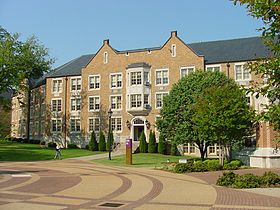 Many U.S. public universities began as teacher training institutions and eventually were expanded into comprehensive state universities. One example is the University of North Alabama, formerly Florence State Teachers College, located in Florence, Alabama.
Many U.S. public universities began as teacher training institutions and eventually were expanded into comprehensive state universities. One example is the University of North Alabama, formerly Florence State Teachers College, located in Florence, Alabama.
States generally charge higher tuition to out-of-state students, a practice which the United States Supreme Court has deemed constitutional because the state is acting as a market participant providing a service, rather than protecting a fundamental right.[citation needed] The higher fees are based on the theory that students from the state, or much more often their parents, have contributed to subsidizing the university by paying state taxes, while of out-of-state students and their parents have not. It has never been determined whether the U.S. Constitution would allow the federal government to establish a federal university system; the only federally chartered universities that currently exist are those under the auspices of the U.S. military, such as West Point.
Historically, many of the prestigious universities in the United States have been private. Some public universities are also highly prestigious and increasingly selective though; Richard Moll designated such prestigious public universities Public Ivies. At schools like University of Michigan, UCLA, University of California, Berkeley, UC San Diego, University of Virginia, and the University of North Carolina at Chapel Hill, a vast majority of the departments are consistently highly ranked. State support of public universities has been declining, forcing many public universities to seek private support. Some professional graduate programs in law, business, and medicine rely almost solely on private funding.
There are also a number of public liberal arts colleges, including the members of the Council of Public Liberal Arts Colleges.
See also
References
- ^ [1]
- ^ [2]
- ^ http://www.um.es/estudios/normas-academicas/2010-2011/precios-publicos.pdf
- ^ "公立大学について [About public universities in Japan]" (in Japanese). http://www.mext.go.jp/a_menu/koutou/kouritsu/. Retrieved 2011-09-07. "[...] とりわけ公立大学は、その目的に加え、地方公共団体が設置・管理するという性格から、地域における高等教育機会の提供と、地域社会での知的・文化的拠点として中心的役割を担ってきており、今後とも、それぞれの地域における社会・経済・文化への貢献が期待されています。[...](Translation: [...] Especially, the public university, because of its goal as well as nature of the institute established and administered by local governments, has begun to offer opportunity of higher education and take the central role as informational and cultural center in regional community and has been expected to contribute to society, economics and culture in each community from now on. [...])"
- ^ "FY2003 White Paper on Education, Culture, Sports, Science and Technology [1.2.1.3"]. 2003. http://www.mext.go.jp/b_menu/hakusho/html/hpac200301/hpac200301_2_023.html. Retrieved 2008-02-11.
- ^ "平成19年度学生納付金調査結果-文部科学省" (in Japanese). http://www.mext.go.jp/a_menu/koutou/kouritsu/jyugyou/07062930.htm. Retrieved 2008-02-11.
- ^ [3]
- ^ List of Public and Private Universities in Pakistan
- ^ GMA NEWS.TV, RP universities get low rankings; La Salle, UST dropped out of Top 500. Accessed August 19, 2008.
- ^ "History of the University". The University of Buckingham. http://www.buckingham.ac.uk/facts/history/. Retrieved 2 September 2010.
- ^ http://www.bbc.co.uk/news/education-11483638
- ^ Dennis, Farrington; David Palfreyman (2011-02-21). "OFFA and £6000-9000 tuition fees" (PDF). OxCHEPS Occasional Paper No. 39. Oxford Centre for Higher Education Policy Studies. http://oxcheps.new.ox.ac.uk/MainSite%20pages/Resources/OxCHEPS_OP39.pdf. Retrieved 2011-03-20. "Note, however, that any university which does not want funding from HEFCE can, as a private corporation, charge whatever tuition fees it likes (exactly as does, say, the University of Buckingham or BPP University College). Under existing legislation and outside of the influence of the HEFCE-funding mechanism upon universities, Government can no more control university tuition fees than it can dictate the price of socks in Marks & Spencer. Universities are not part of the State and they are not part of the public sector; Government has no reserve powers of intervention even in a failing institution."
- ^ http://www.bbc.co.uk/news/education-11483638
- ^ http://www.bbc.co.uk/news/education-11483638
International Forum of Public Universities (IFPU) Barcelona · Bologna · Brussels · Bucharest · Buenos Aires · California · Charles University in Prague · Cheikh Anta Diop · Chile · Freiburg · Geneva · Haiti · Jawaharlal Nehru · Lomonosov Moscow State · Mohammed V · Montréal · Nagoya · Nankai · Ouagadougou · Paris III · Peking · UNAM
Categories:- Types of university or college
- Public universities
Wikimedia Foundation. 2010.

